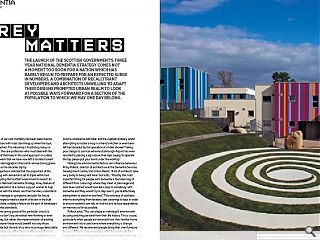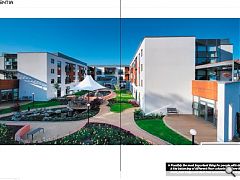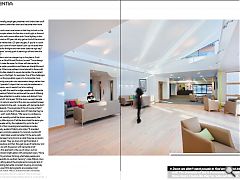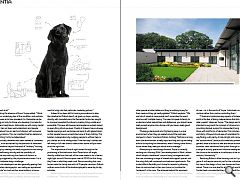Dementia
22 Jul 2013
The launch of the Scottish Government’s three year national dementia strategy comes not a moment too soon for a nation which has barely begun to prepare for an expected surge in numbers. A combination of recalcitrant developers and architects unwilling to adapt their designs prompted Urban Realm to look at possible ways forward for a section of the population to which we may one day belong.
Contemplation of our own mortality has been described as society’s last taboo with most clamming up when the topic of death is broached. This reticence is frustrating many on the front line of the care profession who must deal with the consequences of that head in the sand approach on a daily basis and who warn that we have now left it too late to avert detonation of a demographic time bomb whose ticking grows steadily louder as the decades slip by.Current projections indicate that the proportion of the population living with dementia is set to triple within two decades, prompting the Scottish Government to launch its latest three year National Dementia Strategy. A key feature of this plan is the allocation of a named support worker to help those diagnosed with the illness, and their families, understand what it means, manage its symptoms and plan for future care. But this progress masks a dearth of action in the built environment sphere, notably a failure on the part of developers to adopt dementia standards.
If there is one saving grace of this particular crisis it is that the solutions don’t require radical new thinking or even that much money, but rather the implementation of existing guidelines. Moreover these would benefit not only those battling dementia but the rest of us who must wage daily battle with life’s little nuisances rather than meekly accept them as ‘just the way things are’. After all who hasn’t struggled to track down a conference hall toilet, lost the cupboard lottery whilst attempting to locate a mug in a friend’s kitchen or even been left bamboozled by the operation of a hotel shower? Taking poor design to comical extremes Edinburgh Airport has even resorted to placing a sign above their taps saying ‘to operate the tap please put your hand under the worktop’.
Noting how environmental factors can influence behaviour Ricky Pollock, director of architecture at the Dementia Services Development Centre, told Urban Realm: “A lot of architects take very badly to being sent here” but adds, “Possibly the most important thing for people with dementia is the balancing of different floor colourings where they meet. A pale beige and dark blue contrast would look like a step to somebody with dementia and they would try to step over it, you’re effectively asking them to stand on one foot.” This embrace of contrasts informs everything from lavatory seat coverings to taps in order to ensure residents can rely on instinct and reduce dependence on memory as far as possible.
Pollock adds: “You can shape an individual’s environment by using anything personal from their life history. This is crucial, particularly when people are removed from their familiar home environment into a care home where everything is strange and different. We recommend people bring their own furniture because if they’ve been managing with that previously then that’s what they’re most likely to be able to manage when they move. But generally people get presented with brand new stuff all sealed up behind unfamiliar doors and become even more lost.
“The fault with most care homes is that they’re built on the Travelodge principle where the fire door is built right at the end of a dark corridor with rooms either side. Good lighting is also absolutely crucial, an 80 year old only gets a third of the amount of light on their retina that a 20 year old gets. If you’re in a dark corridor and your cone of vision doesn’t pick up the sides then you’ll just head for the light and then what does the sign say? ‘Push bar to open,’ so they push it, alarms go off and then the staff get mad.”
One architect who has stepped up to the plate is Scott Turpie, partner at Nicoll Russell Studios, he said: “Some design principles that make life easier for those with dementia do likewise for the wider population and these are straightforward to incorporate. Others are perhaps more tailored to those with particular difficulties related to severe dementia- the excellent Gradmann Haus in Stuttgart, for example. One of the challenges for architects as the population ages is to incorporate more dementia-friendly principles into mainstream design rather than seeing it as a ‘specialist’ subject that can only be addressed in care environments- and it needn’t be ‘all or nothing’.
Contending with the need to nudge people with dementia in the right direction Pollock has embraced the use of differing materials to draw attention to public routes and distract from cupboards and off- limit areas. “All the doors we want people to find we left in natural wood and the ones we wanted to keep hidden we painted into the wall - so people with dementia don’t end up in cupboards. The downside of this of course is that if someone comes out of one of those doors it’ll look like they’ve come out the wall!”, adds Pollock. “We were in a conference venue in Belfast recently and all the doors were exactly the same, with tiny little signs on. If all the doors look the same you can be sure people will try the cupboard to go to the loo.”
Fine detail in floor coverings and worktops provides another quandry explains Pollock who notes: “A speckled worktop pattern prompts people to try to brush crumbs off, a fine grain or plain black would be better. It’s the same with carpets, people keep trying to pick up what they see as specks of dirt on the carpet. They go down and get frustrated, it becomes compulsive and then they get issues of behaviour and it’s nothing to do with the person with dementia at all.”
Central to this approach is the use of colour, such as painting toilet doors bright yellow with pictograph signs. “None of this costs, it’s just about thinking what helps people who don’t have the ability to use their memory”, notes Pollock. He is particularly scathing about the private sectors singular lack of appetite in building dementia compliant housing, an anomaly given that the over 50’s demographic are societies most affluent. Pollock noted: “House builders tend to completely ignore us because they think it’s irrelevant. They’re not even thinking about it let alone doing anything about it, so we’ve had almost no interest at all.”
Contemplating this absence of focus Turpie added: “I think there is simply an underlying fear of the condition, and perhaps a lack of awareness as to how prevalent it is. Dementia can be very distressing not only for those who develop it, but also for family, friends and neighbours. Historically, as with many mental health issues, it has not been well understood, and people can be unsure about how to react and interact with someone who displays symptoms. This can manifest itself as denial and isolation, something ‘not to be talked about’.
“I think historically dementia has been viewed as ‘someone else’s problem’, to be addressed by the provision of dedicated care homes, somehow beyond the remit of “ordinary” housing. Design can help by creating discreetly supportive surroundings that promote well-being, activity and the possibility of interaction; while also reducing the chance of distress or confusion being triggered by the physical environment. It is a fascinating and delicate design challenge.
“Private sector developers are also generally gearing their product to a certain demographic, and selling an aspirational idealised “lifestyle” as much as they are a building- a happy, healthy future; comfort, affluence, success. Contemplating illness and negative thoughts is probably the last thing they want to bring into that particular marketing picture.”
Instead it has been left to housing associations to take the initiative but Pollock hasn’t yet given up hope, working directly with manufacturers the Dementia Centre has sought to improve household furniture by making things visible and accessible. This sees sills lowered and appliance sockets raised so everything sits at eye level. Chests of drawers have cut away handle openings and wardrobes are back lit with glazed doors so that people have an unrestricted view of their clothing. This bolsters independence by nudging people to without help or put clothes on in the wrong order. If the next day’s clothes are left ready in full view there’s chance their owner will put them on at the right time.
The importance of line of sight carries through to the positioning of the bathroom door. Placed at an off angle, directly visible from the bed, all the carer needs to do is leave a night light on and if the occupant rises at 02:00 the first thing they’ll see is what they need most. Recommending that care homes cater for family size units of 10 people maximum Pollock outlines some tricks of the trade employed to ease day to day activities.
Replica period money for instance, which is useful for men in particular. “Their meal is a restaurant because there are other people at other tables and they’ve nothing to pay for their meal and they get really agitated,” Pollock explains. “We use lots of visuals in case people can’t remember the word, what we call ‘multiple clueing.’ You need to speak to family to understand what natural likes and dislikes are, you should never really accept anyone into a home until you have a really good background.
“People go backwards at a frightening pace in a care environment when they are seated around the perimeter slumped in chairs,” mentions Pollock. Adding: “Skill loss in a long term care environment is really rapid and they end up not being able to do anything for themselves, even if having come from a house where they were just about able to manage.”
Attempting to move things forward Turpie is currently working on a Housing With Care development in West Lothian which adopts a traditional ‘core and wing’ arrangement with the core containing a range of shared and support spaces, and the wings fully self-contained one-bedroom apartments. This model affords flexibility and choice for tenants by allowing them to cook and eat in their own home, or to utilise the ‘restaurant’ in the core. The rationale behind this approach being that care is moulded to the needs of the individual, rather than the individual conforming to a ‘one size fits all’ model of care – or, in the words of Turpie: ‘individuals control their routines rather than routine controlling them.’
“Choice and control are key aspects of independent living, and it is the fear of losing independence that distresses many older people”, observes Turpie: ”The design and layout is intended to augment this concept of choice and control by providing discreet support to independent living, including for those with mild forms of dementia. This includes open-ness and clarity of layouts to aid ease of orientation for confident wayfinding, with plenty of natural light and connections to the ‘outside world’ (both public street and private courtyard garden); ease of access to safe and secure outside space and activities; clear transitions from public through to private space; a range of activity spaces and informal seating areas offering the choice to be sociable or to withdraw; all set within a relaxed, ordinary ‘domesticity’.”
Resolving Britain’s other housing crisis isn’t just a numbers game. It will require care not just for the individuals directly but care in the design of our care homes and housing from the outset. There is no one size fits all approach and the Dementia Centre freely concede that they don’t have all the answers, particularly when designing for an average of ideas when every individual is different.
|
|
Read next: Liverpool Central Library
Read previous: Cockenzie Power Station
Back to July 2013
Browse Features Archive
Search
News
For more news from the industry visit our News section.
Features & Reports
For more information from the industry visit our Features & Reports section.






